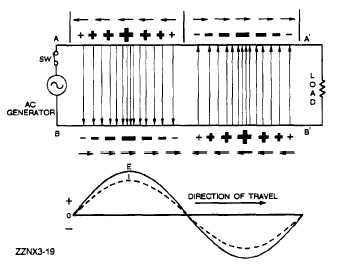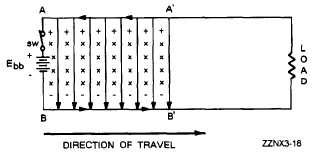is closed, neither current nor voltage exists on the line.
When the switch is closed, point A becomes a positive
potential, and point B becomes negative. These points
of difference in potential move down the line.
However, as the initial points of potential leave points
A and B, they are followed by new points of difference
in potential, which the battery adds at A and B. This
is merely saying that the battery maintains a constant
potential difference between points A and B. A short
time after the switch is closed, the initial points of
difference in potential have reached points A’ and B’;
the wire sections from points A to A’ and points B
to B’ are at the same potential as A and B, respec-
tively. The points of charge are represented by plus
(+) and minus (-) signs along the wires, The directions
of the currents in the wires are represented by the
arrowheads on the line, and the direction of travel is
indicated by an arrow below the line. Conventional
lines of force represent the electric field that exists
between the opposite kinds of charge on the wire
sections from A to A’ and B to B’. Crosses (tails of
arrows) indicate the magnetic field created by the
electric field moving down the line. The moving
electric field and the accompanying magnetic field
constitute an electromagnetic wave that is moving from
the generator (battery) toward the load. This wave
travels at approximately the speed of light in free
space. The energy reaching the load is equal to that
developed at the battery (assuming there are no losses
in the transmission line). If the load absorbs all of
the energy, the current and voltage will be evenly
distributed along the line.
Ac Applied to a Transmission Line
When the battery of figure 3-7 is replaced by an
ac generator (fig. 3-8), each successive instantaneous
value of the generator voltage is propagated down the
Figure 3-7.—Dc voltage applied to a line.
Figure 3-8.—Ac voltage applied to a line.
line at the speed of light. The action is similar to the
wave created by the battery, except the applied voltage
is sinusoidal instead of constant. Assume that the
switch is closed at the moment the generator voltage
is passing through zero and that the next half cycle
makes point A positive. At the end of one cycle of
generator voltage, the current and voltage distribution
will be as shown in figure 3-8.
In this illustration the conventional lines of force
represent the electric fields. For simplicity, the
magnetic fields are not shown. Points of charge are
indicated by plus (+) and minus (-) signs, the larger
signs indicating points of higher amplitude of both
voltage and current. Short arrows indicate direction
of current (electron flow). The waveform drawn below
the transmission line represents the voltage (E) and
current (I) waves. The line is assumed to be infinite
in length so there is no reflection. Thus, traveling
sinusoidal voltage and current waves continually travel
in phase from the generator toward the load, or far
end of the line. Waves traveling from the generator
to the load are called INCIDENT WAVES. Waves
traveling from the load back to the generator are called
REFLECTED WAVES and will be explained in later
paragraphs.
STANDING-WAVE RATIO
The measurement of standing waves on a transmis-
sion line yields information about equipment operating
3-5




